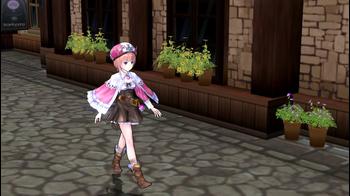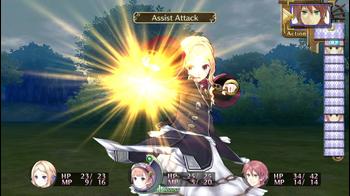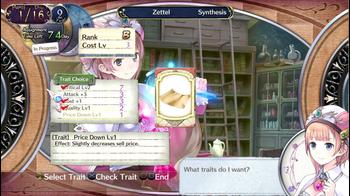
Atelier Rorona Plus Review
After getting my first taste of the series with the recent release of Atelier Escha & Logy, I feel that my interest has been piqued. The series itself hasn’t gotten much exposure with the general RPG populace since Atelier first appeared in the West a little over ten years ago with the release of Atelier Iris, a game I have only had a passing interaction with among Gust’s library.
To me, Atelier Escha & Logy provided elements that I crave from an enjoyable RPG experience: a focus on character development, smart writing, unique visuals, and a beautiful soundtrack. Little did I know that this has been a staple for years, and I got a real taste of that with the remake of the first entry that appeared on the PlayStation 3 with Atelier Rorona Plus.
The young protagonist Rorona has just been told that the atelier shop that she has been forced to work in to pay off a giant debt that her parents have accrued is in danger of being shut down by the kingdom. Beneath the tutelage of the master alchemist Astrid, it's up to Rorona to complete a sequence of 12 assignments over the course of three years that escalate in difficulty throughout the game.
Do the math, and you have three months to complete each major assignment that ranges from synthesizing specific items to defeating monsters that threaten the kingdom’s populace. Aside from the main assignment, there are a wide assortment of optional tasks that grant you stamps for each completion. These stamps can be used to fill is what is basically a Bingo card represented by a 3x3 grid - a feature that is new Atelier Rorona but has been present in later entries.
Filling in the Bingo card either horizontally, vertically, or diagonally unlocks different bonuses like stat boosts and money. Many of these quests also grant you vouchers that can be used at the Front Desk where quests are given to buy a range of highly rare items like strong weapons and even costumes for party members. It’s a highly rewarding system that encourages effort and makes the time spent in Atelier Rorona Plus that much more engaging.
Everything is dictated by the progression of time. Want to craft an item? You’ll be spending at least a day making it. Want to travel to a dungeon on the other side of the map? That may take around seven days to reach, sacrificing even more time traveling from the sub-areas within the dungeon. Time management is vital here, though to be fair I rarely had a problem completely the array of objectives given to me. Of course, if you want to complete everything given to you to collect trophies, it’s important to plan out what you’re doing from the very beginning. Otherwise, I never had the sense that I was being put under any real pressure especially since the important assignments can be completed with practically the bare minimum of effort.
Expect to do a lot of traveling in order to gather the different ingredients needed for synthesis. The various merchants around town can satisfy many of the common items Rorona will make, but in order to craft some of the more high-level items and equipment, it will be important to scavenge the deepest part of the dungeons on a continuous basis. Thankfully, later on, the game gives you a “mule” of sorts who will synthesize specific items or go out and gather materials for you while you’re either tending to the shop or off in a completely different location.
The combat system featured in Atelier Rorona Plus is fairly simplistic especially in comparison to the outstanding one in Escha & Logy. Before Rorona leaves town, she is allowed to bring up to two party members with her. Aside from her best friend Cordelia, everyone will be asking for a certain amount as payment for their services that is collected at the end of the term. Of course, the point is that you’ll be making so much money doing quests and from battles that this won’t ever become a real issue.
New to Atelier Rorona Plus is the ability to recruit the kingdom’s secretary Esty (you need to have her in your party as she is ridiculously overpowered) and Rorona’s “mentor” Astrid who is great to have during the more difficult encounters in the game but whom also comes with a high asking price.
Once inside battle, there is very little that you will need to pay attention to. There is an order timeline on the right side of the screen that lets you know whose turn is next which can be manipulated with status effects or by simply defending until you’re next to another party member.
Rorona is the only one who is able to use items, so she takes care of most of the damage mitigation while in combat. Since MP is an important resource that is drained both with special skills and by synthesizing items back at the workshop, you’ll be relying heavily on items to get through especially during the more difficult encounters.
To the right of her portrait is an Assist meter that builds up as the battle goes on. This can be drained by having another party member protect Rorona if she is about to be attacked (though not vice versa) or if Rorona perform special attack, a teammate will be able to step in and land an extra hit to capitalize.
The crafting system has also been overhauled. Using elements from the systems featured in Totori and Meruru, you’ll be combining items from one specific category (such as Plant) to another (such as Oil) to create a brand new item (like a health potion) that takes on the traits of the items you used during the process. Each item carries a cost with it, so you’ll be limited at which traits that can be carried over.
Multiple items can be created at once, but you have to be careful since each item will require the same number of ingredients to craft them, so you may wind up with a few great items a bunch of low quality throwaways.
This may sound complex at first, but it’s pretty easy to get a hang of after a few tries. Thankfully, the game offers a wide assortment of tutorials that are displayed when a feature is first introduced and more in-depth guides and reference manuals for those wanting more thorough explanations to help them through the entire experience, something that was apparently missing in the original.
As one can imagine, Gust has learned a lot over the years when it comes to the facets of game design and providing a streamlined interface to make their titles for more accessible to players, especially as they try to wrap their heads around the more complex systems found in the series.
I actually played the original Atelier Rorona years ago and was immediately put off by how difficult the game was and how incredibly vague the assignments could be. Atelier Rorona Plus makes some dramatic improvements across the board: the synthesis system has been streamlined, character models more accurately represent their 2D art (thanks to Gust bringing back original artist Kishida Mel to supervise the process); navigation is a lot more manageable; and much more.
The soundtrack from the original game makes its grand return once again showing off how important Gust’s sound team to their identity, providing plenty of memorable tracks set to wonderful visuals that really shows off how much work has gone into Atelier Rorona Plus.
One of the coolest features in the game is the ability to go into the Options menu and change the background music in the different areas in the game to an entirely different track, and it gives you the option to choose music from many of Gust’s other titles including the Mana Khemia series and the very first iteration of the series, Atelier Marie. Want to listen to “Nefertiti” while walking around town? You can do that, and that’s fantastic.
Atelier Rorona Plus represents the perfect entry point for newcomers and a strong case for those who already own a original copy of the game to put their money down for the remake since it also provides plenty of additional cutscenes that help provide growth to some of the more underdeveloped characters in the original along with dozens of endings to unlock.
The significant improvements that have been made over its predecessor is profound, smoothing over all of the imperfections that made it so unappealing to begin with. There is constantly something to do in the world with plenty of cutscenes to witness and objectives to complete, which, along with its pick-up-and-play nature that is repetitive by design, is fun in small doses, unless you’re someone like me who is totally into this sequence pattern and doesn’t mind spending hours visiting the quest counter every single day.
Watching Rorona grow from an innocent girl forced into a difficult situation into an independent and assertive individual is very appealing, and the rest of the cast helps round out what is altogether a fun, light-hearted time that doesn’t try and aim to be this grand adventure but instead a concentrated slice-of-life tale.
This one comes highly recommended for anyone looking for a more laid-back but long-lasting experience that is completely packed with additional content. When you’re done, Atelier Totori Plus and Atelier Meruru Plus are there waiting for you.




